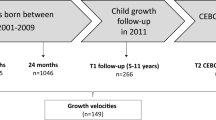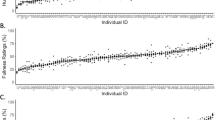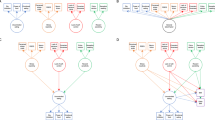Abstract
Background/Objective:
Appetitive traits and general temperament traits have both been correlated with adiposity and obesity in children. However, very few studies have tested structural models to identify the links between temperament, appetitive traits and adiposity in children. A validated structural model would help suggesting mechanisms to explain the impact of temperament on body mass index (BMI). In this study, we used Rothbart’s heuristic definition of temperament as a starting point to define four appetitive traits, including two appetite reactivity dimensions (Appetite Arousal and Appetite Persistence) and two dimensions of self-regulation in eating (Self-regulation In Eating Without Hunger and Self-regulation in Eating Speed). We conducted a cross-sectional study in young adolescents to validate a structural model including these four appetitive traits, Effortful Control (a general temperament trait) and adiposity.
Subjects/Methods:
A questionnaire assessing the four appetitive trait dimensions and Effortful Control was completed by adolescents from 10 to 14 years old (n=475), and their BMI-for-age was calculated (n=441). In total, 74% of the study participants were normal weight, 26% were overweight and 8% were obese. We then used structural equation modelling to test the structural model.
Results:
We identified a well-fitting structural model (Comparative Fit Index=0.91; Root Mean Square Error of Approximation=0.04) that supports the hypothesis that Effortful Control impacts both dimensions of self-regulation in eating, which in turn are linked with both appetite reactivity dimensions. Moreover, Appetite Persistence is the only appetitive trait that was significantly related to adiposity (B=0.12; P<0.05).
Conclusions:
Our model shows that Effortful Control is related to adiposity through the mediation of an individual’s ‘eating temperament’ (appetite reactivity and self-regulation in eating). Results suggest that young adolescents who exhibit high appetite reactivity but a low level of self-regulation in eating are at higher risk for excess adiposity.
This is a preview of subscription content, access via your institution
Access options
Subscribe to this journal
Receive 12 print issues and online access
$259.00 per year
only $21.58 per issue
Buy this article
- Purchase on Springer Link
- Instant access to full article PDF
Prices may be subject to local taxes which are calculated during checkout


Similar content being viewed by others
References
Barsh GS, Farooqi IS, O'Rahilly S . Genetics of body-weight regulation. Nature 2000; 404: 644–651.
Blundell JE, Stubbs RJ, Golding C, Croden F, Alam R, Whybrow S et al. Resistance and susceptibility to weight gain: individual variability in response to a high-fat diet. Physiol Behav 2005; 86: 614–622.
Flier JS . Obesity wars: molecular progress confronts an expanding epidemic. Cell 2004; 116: 337–350.
Hill JO . Obesity and the environment: where do we go from here? Science 2003; 299: 853–855.
Carnell S, Wardle J . Appetitive traits and child obesity: measurement, origins and implications for intervention. Proc Nutr Soc 2008; 67: 343.
Carnell S, Wardle J . Appetitive traits in children. New evidence for associations with weight and a common, obesity-associated genetic variant. Appetite 2009; 53: 260–263.
Wardle J, Guthrie CA, Sanderson S, Rapoport L . Development of the children's eating behaviour questionnaire. J Child Psychol Psychiatry 2001; 42: 963–970.
van Strien T, Oosterveld P . The children's DEBQ for assessment of restrained, emotional, and external eating in 7- to 12-year-old children. Int J Eat Disord 2008; 41: 72–81.
Fisher JO, BIRCH LL . Eating in the absence of hunger and overweight in girls from 5 to 7 y of age. Am J Clin Nutr 2002; 76: 226–231.
Sleddens EF, Kremers SP, Thijs C . The children's eating behaviour questionnaire: factorial validity and association with Body Mass Index in Dutch children aged 6-7. Int J Behav Nutr Phys Act 2008; 5: 49.
Viana V, Sinde S, Saxton JC . Children's eating behaviour questionnaire: associations with BMI in Portuguese children. Br J Nutr 2008; 100: 445–450.
Braet C, van Strien T . Assessment of emotional, externally induced and restrained eating behaviour in nine to twelve-year-old obese and non-obese children. Behav Res Ther 2003; 35: 863–873.
BIRCH LL, Fisher JO, Davison KK . Learning to overeat: maternal use of restrictive feeding practices promotes girls’ eating in the absence of hunger. Am J Clin Nutr 2003; 78: 215–220.
van Jaarsveld CH, Llewellyn CH, Johnson L, Wardle J . Prospective associations between appetitive traits and weight gain in infancy. Am J Clin Nutr 2011; 94: 1562–1567.
Graziano PA, Calkins SD, Keane SP . Toddler self-regulation skills predict risk for pediatric obesity. Int J Obes (Lond) 2010; 34: 633–641.
Niegel S, Ystrom E, Vollrath ME . Is difficult temperament related to overweight and rapid early weight gain in infants? A prospective cohort study. J Dev Behav Pediatr 2007; 28: 462–466.
Wu T, Dixon WE, Dalton WT, Tudiver F, Liu X . Joint effects of child temperament and maternal sensitivity on the development of childhood obesity. Matern Child Health J 2010; 15: 469–477.
Zeller MH, Boles RE, Reiter-Purtill J . The additive and interactive effects of parenting style and temperament in obese youth seeking treatment. Int J Obes (Lond) 2008; 32: 1474–1480.
Burton P, Wells JCK, Kennedy K, Nicholl R, Khakoo A, Fewtrell MS . Association between infant correlates of impulsivity—surgency (extraversion)—and early infant growth. Appetite 2011; 57: 504–509.
Darlington A-SE, Wright CM . The influence of temperament on weight gain in early infancy. J Dev Behav Pediatr 2006; 27: 329–335.
Graziano PA, Kelleher R, Calkins SD, Keane SP, Brien MO . Predicting weight outcomes in preadolescence: the role of toddlers’ self-regulation skills and the temperament dimension of pleasure. Int J Obes (Lond) 2012; 37: 937–942.
Anzman SL, BIRCH LL . Low inhibitory control and restrictive feeding practices predict weight outcomes. J Pediatr 2009; 155: 651–656.
Tan CC, Holub SC . Children’s self-regulation in eating: associations with inhibitory control and parents’ feeding behavior. J Pediatr Psychol 2011; 36: 340–345.
Haycraft E, Farrow C, Meyer C, Powell F, Blissett J . Relationships between temperament and eating behaviours in young children. Appetite 2011; 56: 689–692.
Simonds J, Kieras JE, Rueda MR, Rothbart MK . Effortful control, executive attention, and emotional regulation in 7–10-year-old children. Cogn Dev 2007; 22: 474–488.
Caspi A, Henry B, McGee RO, Moffitt TE . Temperamental origins of child and adolescent behavior problems: from age three to age fifteen. Child Dev 1995; 66: 55–68.
Manfredi C, Caselli G, Rovetto F, Rebecchi D, Ruggiero GM, Sassaroli S et al. Temperament and parental styles as predictors of ruminative brooding and worry. Personal Individ Differ 2011; 50: 186–191.
Rothbart MK . Temperament in childhood: a framework. In Kohnstamm GA, Bates JE, Rothbart MK (eds). Temperament In Childhood. John Wiley & Sons: Australia, 1989, pp 59–73.
Posner MI, Rothbart MK . Developing mechanisms of self-regulation. Dev Psychopathol 2000; 12: 427–441.
Dietz WH . Critical periods in childhood for the development of obesity. Am J Clin Nutr 1994; 59: 955–959.
de Onis M . Development of a WHO growth reference for school-aged children and adolescents. Bull World Health Organ 2007; 85: 660–667.
Kringelbach ML, Stein A, van Hartevelt TJ . Physiology & Behavior. Physiol Behav 2012; 106: 307–316.
Rothbart MK, Rueda MR . The development of effortful control. In Mayr U, Awh E, Keele S (eds). Developing Individuality In The Human Brain: A Tribute To Michael I. Posner. American Psychological Association: Washington, DC, USA, 2005, pp 167–188.
Berridge KC, Robinson TE, Aldridge JW . Dissecting components of reward: ‘liking’, “wanting”, and learning. Curr Opin Pharmacol 2009; 9: 65–73.
Kokkinos A, le Roux CW, Alexiadou K, Tentolouris N, Vincent RP, Kyriaki D et al. Eating slowly increases the postprandial response of the anorexigenic gut hormones, peptide YY and glucagon-like peptide-1. J Clin Endocrinol Metab 2010; 95: 333–337.
Capaldi DM, Rothbart MK . Development and validation of an early adolescent temperament measure. J Early Adolesc 1992; 12: 153–173.
Ellis LK, Rothbart MK . Revision of the Early Adolescent Temperament Questionnaire Poster presented at the 2001 Biennial Meeting of the Society for Research in Child Development Minneapolis, Minnesota 2001.
Rosseel Y . Lavaan: An R Package for Structural Equation Modeling and More Version 0.3-1 Ghent University: Belgium, 2010.
Bollen KA . Structural Equations with Latent Variables. Wiley-Interscience: New York, NY, USA, 1989.
Byrne BM . Structural Equation Modeling With Lisrel, Prelis, and Simplis. Psychology Press: New York, NY, USA, 2013.
Hu LT, Bentler PM . Cutoff criteria for fit indexes in covariance structure analysis: conventional criteria versus new alternatives. Struct Equ Model Multidiscip J 1999; 6: 1–55.
Christopher Westland J . Lower bounds on sample size in structural equation modeling. Electron Commer Res Appl 2010; 9: 476–487.
Monnery-Patris S, Rigal N, Chabanet C, Boggio V, Lange C, Cassuto DA et al. Parental practices perceived by children using a French version of the Kids’Child Feeding Questionnaire. Appetite 2011; 57: 161–166.
Carper JL, Orlet Fisher J, Birch LL . Young girls' emerging dietary restraint and disinhibition are related to parental control in child feeding. Appetite 2000; 35: 121–129.
Kenny DA, Kashy DA . Analysis of the multitrait multimethod matrix by confirmatory factor analysis. Psychol Bull 1992; 112: 165–172.
Huang TT-K, Howarth NC, Lin B-H, Roberts SB, McCrory MA . Energy intake and meal portions: associations with BMI percentile in U.S. children. Obes Res 2004; 12: 1875–1885.
Berridge KC . Physiology & behavior. Physiol Behav 2009; 97: 537–550.
Epstein LH, Paluch R, Coleman KJ . Differences in salivation to repeated food cues in obese and nonobese women. Psychosom Med 2005; 58: 160–164.
Feur E, Labeyrie C, Boucher J, Eïd A, Cabut S, Dib S et al. Indicateurs de santé chez les collégiens et lycéens du Val-de-Marne, France, en 2005: excès pondéral, atteinte carieuse et risque de dépression. Bull Épidémiol Hebd 2007; 4: 29–33.
Ashcroft J, Semmler C, Carnell S, van Jaarsveld CHM, Wardle J . Continuity and stability of eating behaviour traits in children. Eur J Clin Nutr 2007; 62: 985–990.
Farrow C, Blissett J . Stability and continuity of parentally reported child eating behaviours and feeding practices from 2 to 5 years of age. Appetite 2012; 58: 151–156.
Webber L, Cooke L, Hill C, Wardle J . Associations between children’s appetitive traits and maternal feeding practices. J Am Diet Assoc 2010; 110: 1718–1722.
Johnson SL . Improving preschoolers' self-regulation of energy intake. Pediatrics 2000; 106: 1429–1435.
Perels F, Merget-Kullmann M, Wende M, Schmitz B, Buchbinder C . Improving self-regulated learning of preschool children: evaluation of training for kindergarten teachers. Br J Educ Psychol 2010; 79: 311–327.
Nelis D, Kotsou I, Quoidbach J, Hansenne M, Weytens F, Dupuis P et al. Increasing emotional competence improves psychological and physical well-being, social relationships, and employability. Emotion 2011; 11: 354–366.
Acknowledgements
VG and NR designed the research; VG conducted the research; VG and LT analysed the data; VG wrote the paper; VG had primary responsibility for the final content. All authors read and approved the final manuscript. We would like to express our gratitude to N. Darcel, S. Monnery-Patris, M-L Frelut and Emily Crow for their attentive reading of the manuscript. We also thank the FFAS (Fonds Français pour l’Alimentation et la Santé) and the Institut Benjamin Delessert for their financial support.
Author information
Authors and Affiliations
Corresponding author
Ethics declarations
Competing interests
The authors declare no conflict of interest.
Rights and permissions
About this article
Cite this article
Godefroy, V., Trinchera, L., Romo, L. et al. Modelling the effect of temperament on BMI through appetite reactivity and self-regulation in eating: a Structural Equation Modelling approach in young adolescents. Int J Obes 40, 573–580 (2016). https://doi.org/10.1038/ijo.2016.6
Received:
Revised:
Accepted:
Published:
Issue Date:
DOI: https://doi.org/10.1038/ijo.2016.6



